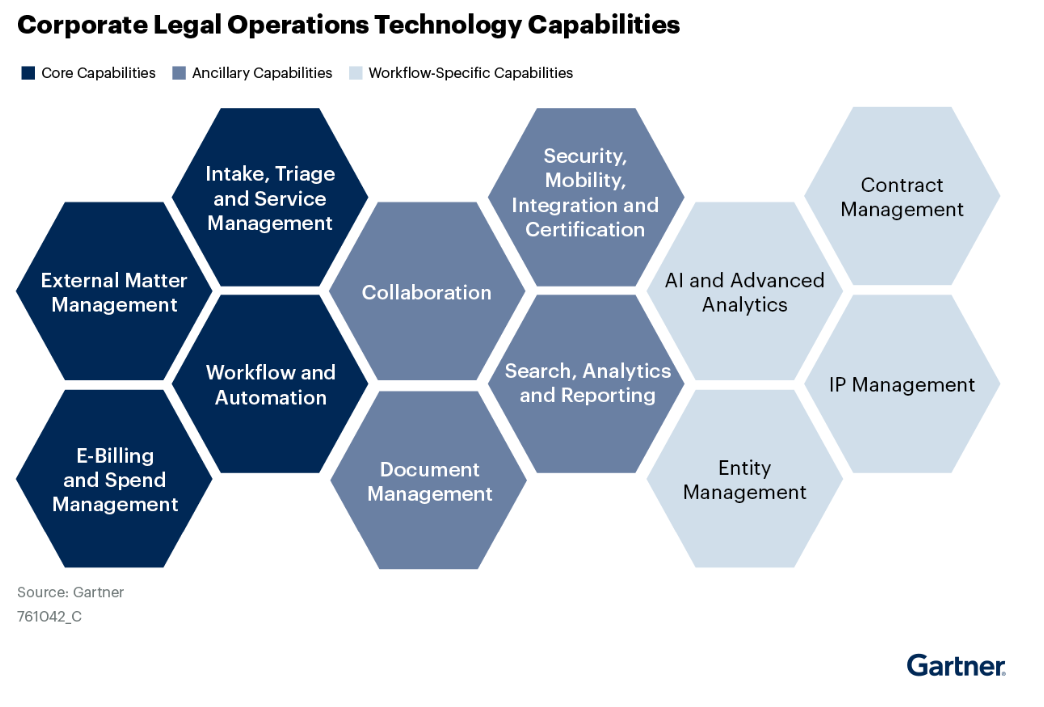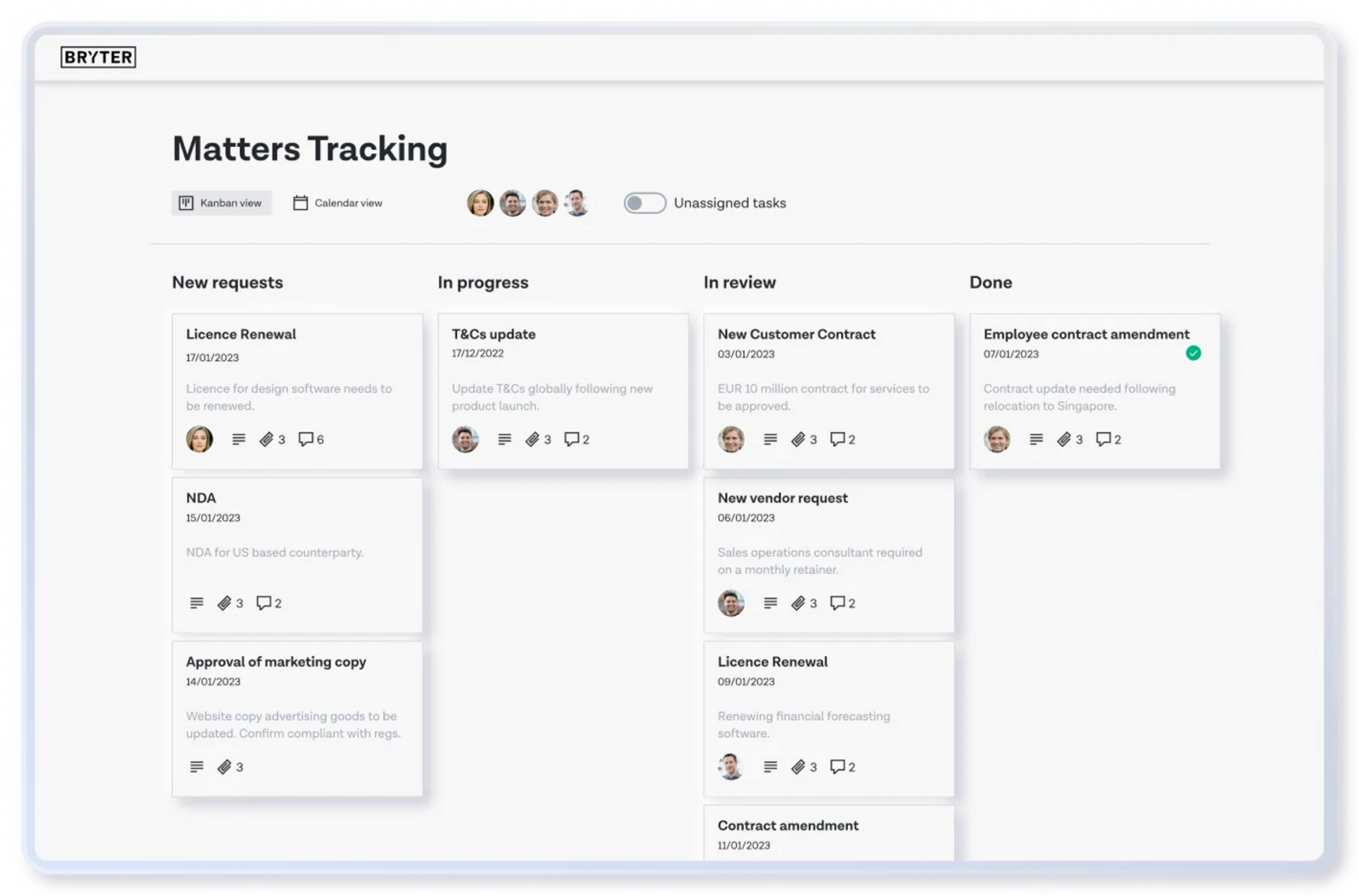Gartner categorizes legal intake and workflow automation as core capabilities for legal departments.
Legal departments are grappling with a crisis: how to manage increased workloads, without additional headcount in an increasingly cost-conscious environment.
A recent Gartner report, based its legal market research, finds that within three years, 40% of all legal departments will have adopted workflow technology to streamline intake and triage.
In our own report on GCs’ top concerns, 69% of respondents identified the same top problem: managing workloads against time and resources. This pressure has been building for years, and now legal ops leaders are turning to software to meet the needs of modern businesses.
Why focus on intake and triage? In short, it’s a quick win. Legal teams spend hours of their time managing requests coming into their department, distributing them across the team, and chasing communications across multiple channels. Managing intake and triage manually takes focus away from building relationships with the business and limits the amount of actual legal work the team can complete.
Fortunately, technology has advanced to the point where it can address many of these issues quickly, easily, and without extensive training and adoption cycles. And these solutions are built specifically for legal departments. There are legal intake solutions and custom no-code workflow automation technologies that can be tailored to even the most unique challenges faced by corporate legal departments.
Here, we explore some of the key insights from Gartner’s 2023 Market Guide for Corporate Legal Operations Technology, including how legal intake is changing, how Legal teams are addressing the current market’s challenges, and what organizations can do to tackle these issues.
By 2026, 40% of all legal departments will have adopted workflow technology to streamline intake and triage.
Gartner, 2023 Market Guide for Corporate Legal Operations Technology
Gartner’s 4 new core capabilities of legal ops technology
Historically, “legal tech” referred mainly to document management (a “digital filing cabinet”) and e-billing. This has changed. Now, legal leaders look to technology to solve a broader range of efficiency problems.
Gartner redefined the 4 core capabilities of legal ops technology to reflect the current state of the market:
- Intake, Triage, and Service Management: This software streamlines intake, allowing Legal teams to quickly capture and organize incoming requests, assign them to the right team member, and track and report on the progress of each request.
- Workflow and Automation: Legal workflow automation digitally enables processes to maximize the Legal team’s efficiency, eliminate errors, and provide more value to the business
- External Matter Management: This refers to tech that helps teams effectively manage and track matters arising from external sources.
- E-Billing and Spend Management: These tools help teams manage law firm invoices, gain visibility over work done by outside counsel, and manage their overall budget.
These four core capabilities are distinct from Contract Lifecycle Management, which Gartner has carved out as a separate, workflow-specific capability.

Gartner’s top 5 use cases for legal tech
To understand what solutions are rising, we first have to look at the problems legal teams face — the areas that currently aren’t efficient or meeting their business needs. Gartner lists the top 5 use cases for legal tech as follows:
- Collaboration among legal staff
- Legal operations automation
- Internal matter management
- Legal document management
- Intake/legal request management
These are the core, day-to-day elements of legal work that are ripe for improvement. Legal teams spend too much time fielding repetitive requests, chasing additional information, re-routing requests to the right expert, and providing status updates to internal clients. Speaking of internal clients, they lack visibility into the status of their requests, have trouble navigating complicated intranets to find documents, and spend too much time waiting for simple, business-critical legal documents.
The quick wins: Intake and matter management
The problems outlined above can be categorized under the umbrella of intake and matter management. This is the low-hanging fruit for Legal teams looking to maximize efficiency. Legal intake and matter management platforms enable better collaboration, greater efficiency, added visibility for the Legal team and their clients, and a substantial reduction in time to resolve a matter.
These solutions include features like:
- Online request intake forms
- Automated request workflows (pre-built and customizable)
- Automated triage and escalation
- Customizable request taxonomy
- No-code application builders
Legal departments can utilize these enhancements to promote cohesive work management, without having to invest heavily in custom development or depend on corporate IT for aid.

Find an all-in-one solution
Gartner suggests that the best way to address the problems outlined above is to go with all-in-one platforms and suites of connected solutions from a single vendor when possible. This helps Legal teams find value in their software investments more quickly by avoiding the hassle that comes with learning new platforms, configuring integrations, and securing IT support on multiple disconnected solutions.
A truly connected legal environment maximizes the value of all software. For example, imagine an NDA request — something common and repetitive, but still sensitive and sometimes carrying bespoke elements. An integrated end-to-end legal workflow management solution could effectively intake the request, gathering all the necessary information and context from the requestor, pre-draft an NDA from that information, share the NDA with the proper expert on the legal team for final review, then disseminate it to the requestor for e-signature, and finally securely store it in the proper secure database after signing. The process we just outlined could use as many as five different solutions or as few as one.
Gartner recommends seeking opportunities to find additional value in legal tech investments by working with a smaller number of vendors that cover your entire legal workflows with integrated solutions.
This doesn’t just provide a better experience for users, but it also greatly helps manage technical infrastructure and makes you more likely to be successful with a solution long-term.
Workflow and automation technology will form the long-term solution
The immediate focus of legal tech spend is going to be on solutions that streamline intake, automate common repetitive workflows, and provide better matter management right off the shelf. But what about those more complicated workflows? Automation is coming for those too.
Gartner’s Guide says that demand is rising for workflow automation software, which enables Legal teams to build and customize solutions without coding or reliance on IT. Legal teams at companies like TD SYNNEX, Telefónica, and ING Banking Group have already used BRYTER’s no-code legal automation platform and achieved up to a 90% reduction in time spent on manual work.
So once you have a baseline of digitization, it’s time to start thinking more broadly about automation. With a no-code automation platform, your logic is documented and solutions become repeatable and scaleable. Rather than solving problems on a 1:1 basis, you modify your existing workflows as needed, so they become more and more powerful and more able to address business needs without manual intervention.
Legal teams need to make smart investments in technology — today
Over 62% of legal leaders anticipate an increase in their technology budgets, despite economic pressures (Gartner: Legal Budget & Efficiency Benchmark, 2022). Gartner recommends that this additional budget be allocated to technology that will quickly improve the department and yield concrete business results. Take into account your specific needs and identify potential outcomes not only for Legal, but for the whole organization.
The Guide cautions against delaying the adoption of legal technology. Unfortunately, many corporate legal departments are still underutilizing technology, sometimes due to reluctance to invest in it until it has been more widely accepted. It is essential that teams embrace technology as soon as possible to gain the experience needed to support future innovation. As the Guide states, another urgent factor is the need to support Legal’s largest investment: its people.
Gartner’s full Market Guide for Corporate Legal Operations Technology is available here.




